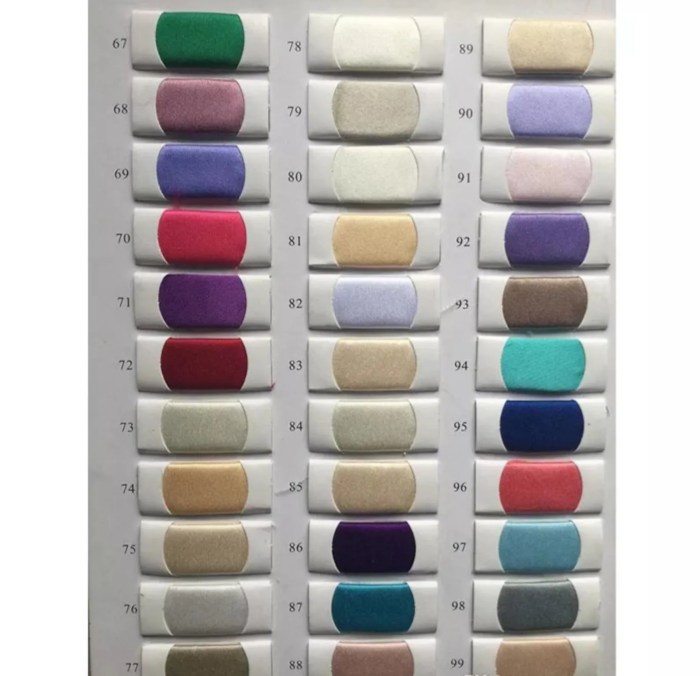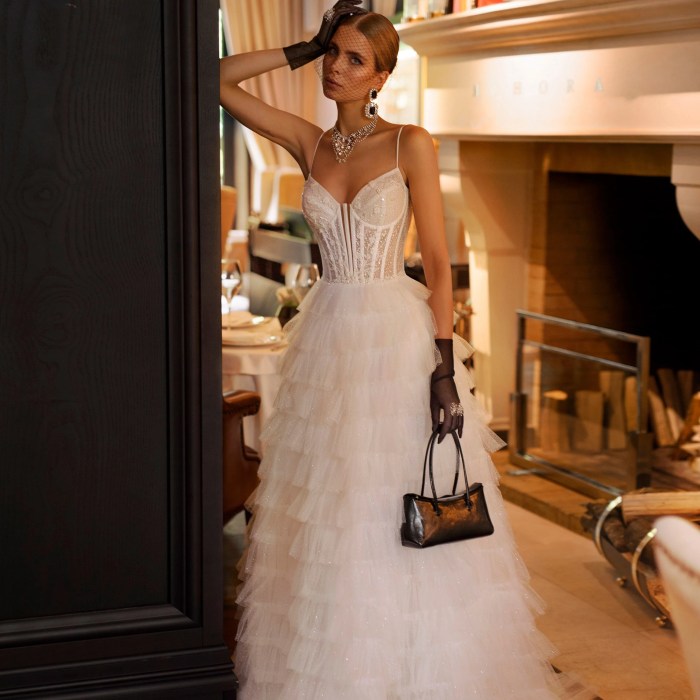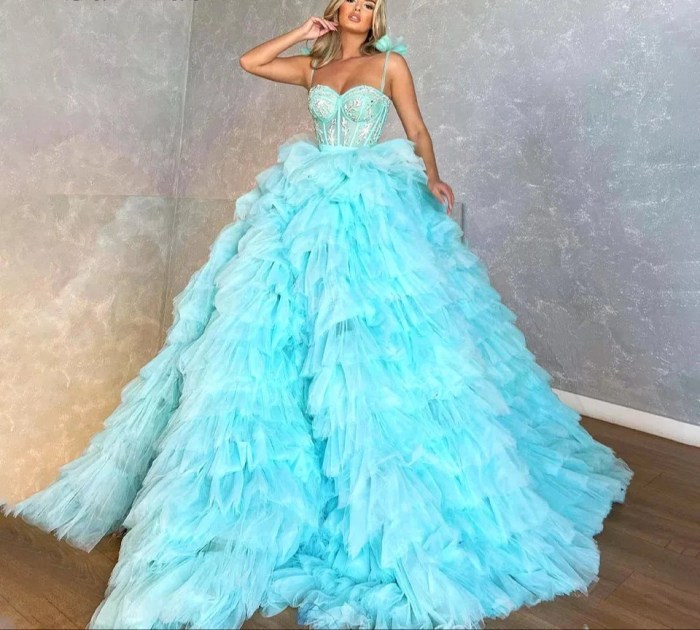Ruffle Tulle Wedding Dresses A Guide
Ruffle Tulle Wedding Dresses: A Guide to Romantic Elegance

Source: etsystatic.com
Ruffle tulle wedding dresses epitomize romantic bridal style, offering a captivating blend of texture, volume, and ethereal beauty. This guide delves into the defining characteristics, design elements, construction techniques, styling options, and current trends of these exquisite gowns, providing a comprehensive overview for brides-to-be.
Defining “Ruffle Tulle Wedding Dress”
A ruffle tulle wedding dress is characterized by the use of tulle, a delicate net-like fabric, adorned with ruffles—gathered or pleated fabric strips—to create texture and movement. The ruffles can range in size, from delicate, almost invisible ripples to large, dramatic cascades. The tulle itself can vary in texture, from soft and flowing to stiff and structured, impacting the overall silhouette and drape of the dress.
Different types of ruffles include single, double, or cascading ruffles; ruffled tiers; and ruffled appliqués. Tulle types include soft tulle, stiff tulle, silk tulle, and embroidered tulle, each offering a unique aesthetic. The combination of ruffle style and tulle type, along with the overall silhouette, creates a wide array of design possibilities.
| Ruffle Style | Tulle Type | Silhouette | Example Description |
|---|---|---|---|
| Cascading ruffles | Soft tulle | A-line | A flowing A-line gown with layers of soft tulle ruffles cascading from the bodice to the hem, creating a romantic and ethereal look. |
| Ruffled tiers | Stiff tulle | Ballgown | A full ballgown with multiple tiers of stiff tulle ruffles, providing structure and volume, resulting in a dramatic and regal silhouette. |
| Single ruffles | Silk tulle | Sheath | A sleek sheath dress with delicate single ruffles along the neckline and hem, offering a subtle yet elegant touch. |
The texture of the tulle significantly affects the dress’s overall look. Soft tulle creates a delicate, flowing silhouette, while stiff tulle provides structure and volume, allowing for more dramatic designs. The choice of tulle depends on the desired level of formality and the overall aesthetic.
Design Elements and Aesthetics
Neckline, sleeve, and train length are crucial design elements that influence the overall aesthetic of a ruffle tulle wedding dress. Careful consideration of these elements can enhance the dress’s beauty and complement the bride’s figure and style.
Various neckline styles, such as sweetheart, V-neck, halter, or off-the-shoulder, can be paired with ruffle tulle dresses, each offering a different level of formality and visual impact. The choice of neckline should complement the bride’s body shape and personal preference.
- Off-the-shoulder sleeves create a romantic and delicate look, often paired with cascading ruffles.
- Long sleeves offer a more formal and elegant feel, suitable for colder weather or a more traditional wedding.
- Sleeveless designs showcase the bride’s arms and shoulders, allowing the ruffles to take center stage.
The train length also plays a significant role. A chapel train adds a touch of elegance, while a cathedral train creates a dramatic and regal effect. The choice depends on the venue and the bride’s personal style.
Fabric and Construction

Source: etsystatic.com
The choice of tulle and construction techniques are paramount in achieving the desired look and feel of the dress. Understanding these aspects is crucial for appreciating the craftsmanship involved.
Various tulle fabrics offer distinct properties. Soft tulle drapes beautifully, creating a flowing silhouette. Stiff tulle holds its shape better, suitable for structured designs. Silk tulle adds a luxurious touch, while embroidered tulle offers intricate detailing. The choice depends on the desired level of formality and the overall aesthetic.
Ruffles are created through various techniques, including gathering, pleating, and shirring. These techniques affect the drape and movement of the dress. Gathering creates soft, flowing ruffles, while pleating results in more structured, defined ruffles. Shirring adds a subtle texture and gathers the fabric.
Lining fabrics, such as silk charmeuse or satin, are used to provide structure, comfort, and a smooth finish. The choice of lining depends on the overall design and the desired level of comfort.
Styling and Accessories

Source: etsystatic.com
Completing the look of a ruffle tulle wedding dress requires careful consideration of hair, makeup, jewelry, footwear, and veils. The following styling concepts demonstrate how these elements can create distinct aesthetics.
Romantic Bohemian: Loose, flowing waves, natural makeup with a focus on glowing skin, delicate gold jewelry, and ankle-strap sandals.
Classic Elegant: A sleek updo, refined makeup with a red lip, statement earrings, and classic heels.
Modern Minimalist: A simple low bun, minimal makeup with a focus on clean lines, subtle jewelry, and pointed-toe flats or low heels.
| Shoe Style | Heel Height | Dress Style Compatibility | Example Description |
|---|---|---|---|
| Ankle-strap sandals | Low to mid-heel | Tea-length or shorter dresses | Delicate ankle-strap sandals complement the romantic feel of a shorter ruffle tulle dress. |
| Classic pumps | Mid to high-heel | Floor-length gowns | Elegant pumps elongate the legs and complement the formality of a long ruffle tulle dress. |
Veils and headpieces should complement the overall style. A cathedral-length veil adds drama to a formal gown, while a birdcage veil provides a vintage touch. A simple hair comb or jeweled headband can add subtle elegance to a more minimalist design.
Market Trends and Inspirations
Current trends in ruffle tulle wedding dresses showcase a blend of classic elegance and modern innovation, often seen in runway shows and bridal collections.
Ruffle tulle wedding dresses offer a delightful blend of romance and whimsy. For brides wanting versatility, consider the option of a detachable element; adding a dramatic effect with a removable train wedding dress allows for a seamless transition from ceremony to reception. This allows you to maintain the airy elegance of your ruffle tulle gown while enjoying the best of both worlds.
A modern interpretation of a classic ruffle tulle wedding dress might feature a sleek silhouette with strategically placed ruffles, perhaps incorporating a high-low hemline and a minimalist neckline. The tulle might be a luxurious silk tulle, and the overall aesthetic would be sophisticated and understated.
Color palettes significantly impact the overall mood. A blush pink tulle creates a soft and romantic feel, while ivory tulle offers classic elegance. A bolder color, such as a deep blue or emerald green, can add a touch of drama and sophistication.
Key Questions Answered
How do I care for a ruffle tulle wedding dress?
Dry cleaning is generally recommended. Check the care label for specific instructions.
Are ruffle tulle wedding dresses suitable for all body types?
Yes, with careful selection of silhouette and ruffle placement, they can flatter various body shapes. Consult with a bridal stylist for personalized advice.
How much does a ruffle tulle wedding dress typically cost?
Prices vary widely depending on designer, fabric quality, and embellishments. Expect a range from several hundred to several thousand dollars.
Can I alter a ruffle tulle wedding dress?
Yes, many alterations are possible, but it’s best to consult a professional seamstress experienced with delicate fabrics.



















